 Mendel rescued Darwin’s theory of natural selection early in the twentieth century – to a point.
Mendel rescued Darwin’s theory of natural selection early in the twentieth century – to a point.
By the end of the nineteenth century, Charles Darwin’s influence had continued to deteriorate, stemming from his obsolete theory of inheritance.
In the search for a scientifically valid theory, scientists, early in the twentieth century, rediscovered Gregor Mendel’s genetic inheritance theory, which had been published thirty years earlier.
Mendel’s theory delivered what Darwin missed – a scientifically valid theory of inheritance capable of driving evolution.
Since then, inheritance merged as the second of Darwin’s five principles of natural selection, abbreviated as V.I.S.T.A. Niles Eldredge, a paleontologist at the American Museum of Natural History, formulated the acronym to understand Darwin’s theory of evolution.
For the museum’s Darwin exhibit, Eldridge uses the acronym to explain how the principles of variation, inheritance, selection, time, and adaptation drive natural selection.
Not surprisingly, even Darwin was skeptical of how inheritance was understood at the time, noting –
“The laws governing inheritance are, for the most part, unknown.”
Mendel, a contemporary of Darwin, unwittingly solved Darwin’s inheritance problem. In 1866, Mendel, a German botanist and mathematician, uncovered the laws governing inheritance in the published paper Experiments on Plant Hybridization by studying the inheritance patterns in pea plants (pictured left).
However, at the time, Mendels’ (pictured right) mathematical inheritance model, misunderstood as a hybridization theory, went unnoticed by naturalists. The rediscovery of Mendel’s theory motivated scientists to develop a new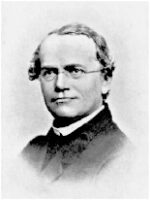 evolution model by integrating Darwin’s theory with Mendel’s inheritance laws.
evolution model by integrating Darwin’s theory with Mendel’s inheritance laws.
By the mid-twentieth century, the movement formulated a gene-centric view of evolution, known as the Modern Synthesis theory.
But why could Mendel crack nature’s inheritance secret while Darwin apparently could not?
On Different Roads
 Academically, Mendel and Darwin (pictured left) traveled different roads — Mendel took the path of science, studying at the University of Olmütz (pictured left) in the Czech Republic, where he excelled in physics and math. While not qualifying to study mathematics, Darwin took the path of liberal arts, enrolling for an ordinary degree at Christ’s College (pictured right) in Cambridge with plans to become an Anglican clergyman.
Academically, Mendel and Darwin (pictured left) traveled different roads — Mendel took the path of science, studying at the University of Olmütz (pictured left) in the Czech Republic, where he excelled in physics and math. While not qualifying to study mathematics, Darwin took the path of liberal arts, enrolling for an ordinary degree at Christ’s College (pictured right) in Cambridge with plans to become an Anglican clergyman.
Concerning their personal lives, Mendel was the son of a struggling farming family, while Darwin enjoyed a privileged heritage. Mendel experienced “perpetual anxiety about a means of livelihood” and entered the Order of Saint Augustine for a salary. Darwin abandoned his clergy plans and never chased work for an income.
livelihood” and entered the Order of Saint Augustine for a salary. Darwin abandoned his clergy plans and never chased work for an income.
Professionally, as an Augustinian friar, Mendel developed an inheritance model mathematically by cultivating and analyzing the traits of 28,000 pea plants (Pisum sativum – pictured above) over four acres in the rolling hills of Brünn between 1856 to 1863. Even though studying numerous plants and animals, Darwin never developed a mathematical model for his observations.
Mendel first reported his findings and theory to the Society for the Study of Natural Science of Brunn. The following year, Mendel published his complete report in Proceedings of the Natural History Society of Brünn in 1866; ironically, the same year, Darwin published the first edition of his inheritance theory – Variation Under Domestication.
In 1866, while Darwin’s popularity soared, Mendel’s work went largely unnoticed. Confidently undeterred, Mendel told his friend Gustav von Niessl –
“My time will come.”
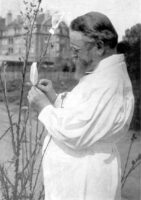 Mendel demonstrated inheritance traits to be controlled by the laws of Segregation and Independence, which toppled Darwin’s proposed blending pangenesis theory. Thirty years later, in 1900, Carl Erich Correns (pictured left), Hugo de Vries, and Erich von Tschermak, working independently, validated Mendels’ theory of inheritance.
Mendel demonstrated inheritance traits to be controlled by the laws of Segregation and Independence, which toppled Darwin’s proposed blending pangenesis theory. Thirty years later, in 1900, Carl Erich Correns (pictured left), Hugo de Vries, and Erich von Tschermak, working independently, validated Mendels’ theory of inheritance.
When seen as a synthesis of Darwin’s and Mendel’s theories, The Origin of Species went from obsolescence to one of the most influential books of the twentieth century, second only to the Bible.
Darwin’s Math Aversion
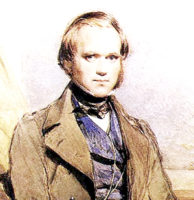 Why did Mendel’s work go unnoticed for so long, especially since Mendel’s inheritance theory solved Darwin’s inheritance problem? The answer is probably mathematics, to which contemporary naturalists, at the time, including Darwin, had an aversion.
Why did Mendel’s work go unnoticed for so long, especially since Mendel’s inheritance theory solved Darwin’s inheritance problem? The answer is probably mathematics, to which contemporary naturalists, at the time, including Darwin, had an aversion.
“Mathematics in biology was like a scalpel in a carpenter’s shop – there was no use for it,” Darwin once chided. Just months before leaving on HMS Beagle, Darwin shared his math self-assessment in a letter to mathematician Charles Thomas Whitley –
“You have hit on, viz irresolution, the other is being made fully aware that my noddle is not capacious enough to retain or comprehend Mathematics.”
Unlike Mendel, none of Darwin’s papers applied mathematics to validate his arguments. Writing in his Autobiography, Darwin regrets not pursuing mathematics further –
“During the three years which I spent at Cambridge, my time was wasted, as far as the academical studies were concerned… I attempted mathematics and even went during the summer of 1828 with a private tutor (a very dull man) to Barmouth, but I got on very slowly. The work was repugnant to me, chiefly from my not being able to see any meaning in the early steps in algebra. This impatience was very foolish, and in after years, I have deeply regretted that I did not proceed far enough at least to understand something of the great leading principles of mathematics; for men thus endowed seem to have an extra sense. But I do not believe that I should ever have succeeded beyond a very low grade.”
Did Darwin Read Mendel’s Paper?
Could Darwin have read Mendel’s 1866 paper and updated the last two editions of The Origin of Species if he had understood the theory? Possibly.
However, any evidence that Darwin read Mendel’s paper has yet to be discovered, even though Mendel very likely sent him a personal copy, as was the standard custom.
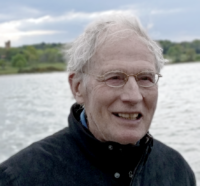 As geneticist David Galton (pictured left), of the University of London, in the 2009 article, “Did Darwin Read Mendel?” published in the International Journal of Medicine, explains –
As geneticist David Galton (pictured left), of the University of London, in the 2009 article, “Did Darwin Read Mendel?” published in the International Journal of Medicine, explains –
“The unsolved mystery therefore remains: did Darwin actually receive a copy of Mendel’s article? And if so, did he bother to read it? A catalogue of Darwin’s library from Down House published in 1908 (26 years after Darwin’s death) did not record any of Mendel’s papers. However, after Darwin’s death in 1882, his scientific library passed to his son Francis… in 1896 following the death of Emma Darwin, and the house then leased to a school…. There was thus ample time for small items [like Mendel’s paper] to go astray.”
Darwin’s library, however, did include works referencing Mendel’s theory, including Hermann Hoffman‘s Untersuchungen Zur Bestimmung des Werthes von Species und Varietät and Wilhelm Olbers Focke‘s book Die Pflanzen-Mischlinge, Ein Beitrag Zur Biologie der Gewächse.
By the late nineteenth century, increasing skepticism over Darwin’s vague and incomplete theory caused, in the words of Julian Huxley, the grandson of Darwin’s Bulldog –
“The eclipse of Darwinism.”
Pivoting
The rediscovery of Mendel’s inheritance model launched a movement to rescue Darwin’s fledgling theory at the turn of the century. Scientists pivoted to develop a scientifically cohesive theory of evolution by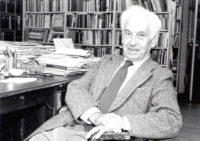 synthesizing the two theories.
synthesizing the two theories.
Facilitating the movement was an emerging technological revolution that allowed scientists’ to search into the uncharted spheres of physics and biology. By the mid-twentieth century, the Modern Synthesis theory became the most widely accepted unifying theory of evolution.
Leaders of the movement included German-American biologist Ernst Mayr (pictured right), American botanist and geneticist G. Ledyard Stebbins, and Ukrainian-American geneticist Theodosius Dobzhansky.
Initially, the search uncovered conflicting perspectives – specifically, the speed of evolution. Darwin’s gradual changes (saltationism) were thought to be incompatible with the perceived faster speed of De Vries’s genetic mutation theory.
However, the brewing controversy over the speed of evolution began to ease with the findings from Thomas Hunt Morgan’s mutation-induced fruit flies tests published in the seminal book The Mechanism of Mendelian Heredity (1915).
Fruit Fly Experiments
 The revolutionary fruit fly experiments by American evolutionary biologist Thomas Morgan (pictured left) proved crucial for the emerging theory. In 1933, Morgan received a Nobel Prize for his inheritance work using the Drosophila melanogaster fruit fly.
The revolutionary fruit fly experiments by American evolutionary biologist Thomas Morgan (pictured left) proved crucial for the emerging theory. In 1933, Morgan received a Nobel Prize for his inheritance work using the Drosophila melanogaster fruit fly.
As a critic of Darwin, Morgan challenged his gradual theory of evolution and argued that more than inherent variations must account for the development of nature’s vast diversity. In his 1903 book Evolution and Adaptation, Morgan challenged Darwin’s variations explanation –
“The adaptation of animals and plants to the conditions under which they live has always excited the interest… this relation between the organism and its environment is one of the most characteristic features of living things. The question at once suggests itself: How has such a relation been brought about? Is it due to something inherent [variations] in the living matter itself, or is it something that has been, as it were, superimposed upon it?”
Morgan found Darwin’s production of “slight, successive” variations by natural selection too slow, arguing that the search for the “causes” of variations “should be our immediate quest,” writing –
“This assumption of the [natural] selectionists has led many of them to ignore a fundamental weakness of their theory, namely, the origin of the variations themselves… The causes of the change of whatever kind should be our immediate quest.”
Bypassing other popular explanations for the origin of variations, Morgan centered on exploring De Vries’s proposed mutation theory of speciation based on Mendelian genetics. In 1908, Morgan began exposing fruit flies to chemicals and radiation to induce variations through genetic mutations.
flies to chemicals and radiation to induce variations through genetic mutations.
Two years later, Morgan associated aberrant white-eyed male fruit flies with a mutant gene. From the evidence, Morgan scientifically verified that genes reside on the chromosomes and genetic mutations are inheritable – resolving earlier skepticism with Mendel’s theory.
Morgan presented his findings in the article “Random Segregation Versus Coupling in Mendelian Inheritance (pictured right),” published in Science 1911. He later validated Mendel’s inheritance laws in his comprehensive treatise, “The Mechanism of Mendelian Heredity,” published in 1915.
Best known as Morgan’s “Chromosome Theory of Heredity,” the mutation theory of speciation appeared widely in biology textbooks by 1930 as the mechanism driving evolution. The Drosophila fruit fly emerged as a popular model species for studying the mechanisms of evolution.
Synthesis Challenged
 Morgan seemingly validated a synthesis of natural selection and Mendel’s theory of genetic inheritance. In 1943, Julian Huxley’s book, “Evolution: The Modern Synthesis (1943),” emerged as a defining work to explain the mechanisms of evolution – a unifying “modern” synthetic view of evolution.
Morgan seemingly validated a synthesis of natural selection and Mendel’s theory of genetic inheritance. In 1943, Julian Huxley’s book, “Evolution: The Modern Synthesis (1943),” emerged as a defining work to explain the mechanisms of evolution – a unifying “modern” synthetic view of evolution.
The Modern Synthesis theory, according to Massimo Pigliucci (pictured right) and Gerd B Műller (pictured right) noted in “Evolution, the Extended Synthesis” (2010), emerged as –
“The standard theoretical paradigm of evolutionary biology.”
However, the emerging genomic revolution increasingly challenged the new synthesis. As Pigliucci and Műller explain –
“For several years now, dissenters from diverse fields of biology have been questioning aspects of the Modern Synthesis.”
Lingering questions long pre-dated the Modern Synthesis theory. On top of the list is how many descendants emerged from Morgan’s fruit fly mutants The answer is none – the acquired white-eyed mutant fruit flies continued mating with other fruit flies. Morgan never observed a speciation event as anticipated.
Mendel rescued Darwin’s theory from extinction to a point during the late twentieth century. However, a speciation [macroevolution] event has never been observed as predicted by the Modern Synthesis theory.
Therefore, a cohesive version of the Modern Synthesis theory of evolution has yet to emerge, and the development of a scientific consensus on a theory of evolution continues beyond the reach of any scientific organization in the twenty-first century.
Genesis
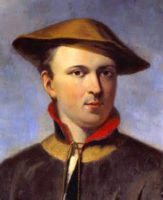 The origin of Earth’s biosphere account in Genesis, written by Moses, is incompatible with an accumulation of random successive genetic mutations over millions of years, as proposed by Darwin’s theory of evolution.
The origin of Earth’s biosphere account in Genesis, written by Moses, is incompatible with an accumulation of random successive genetic mutations over millions of years, as proposed by Darwin’s theory of evolution.
Carolus Linnaeus, a Swedish botanist, physician, and zoologist, founded the modern scheme of species classification during the Scientific Revolution, recognized as the father of modern ecology. The Linnean Society of London, the oldest extant biological society in the world, is named in his honor, appearing on numerous Swedish postage stamps and banknotes. In the words of Linnaeus –
“There are as many species as the Infinite Being created diverse forms in the beginning, which, following the laws of generation [reproduction], produced many others, but always similar to them.”
Developing a scientific consensus on the mechanisms of evolution still remains speculative.
Mendel Rescued Darwin’s Theory is a Theory and Consensus article.
More
Natural selection’s five principles, abbreviated as V.I.S.T.A., include –
-
- Variation, First Evolution Principle
- Inheritance, Second Evolution Principle
- Selection, Third Principle of Evolution
- Time
- Adaptation, Fifth Principle of Natural Selection – under construction
Darwin Then and Now is an educational resource on the intersection of evolution and science, highlighting the ongoing challenges to the theory of evolution.
Move On
Explore how to understand twenty-first-century concepts of evolution further using the following links –
-
- The Understanding Evolution category showcases how varying historical study approaches to evolution have led to varying conclusions. Subcategories include –
- Studying Evolution explains how key evolution terms and concepts have changed since the 1958 publication of The Origin of Species.
- What is Science explains Charles Darwin’s approach to science and how modern science approaches can be applied for different investigative purposes.
- Evolution and Science feature study articles on how scientific evidence influences the current understanding of evolution.
- Theory and Consensus feature articles on the historical timelines of the theory and Natural Selection.
- The Biography of Charles Darwin category showcases relevant aspects of his life.
- The Glossary defines terms used in studying the theory of biological evolution.
- The Understanding Evolution category showcases how varying historical study approaches to evolution have led to varying conclusions. Subcategories include –


